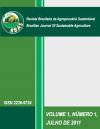MORPHOLOGY OF ELEPHANTGRASS PHYTOMERES
DOI:
https://doi.org/10.21206/rbas.v1i1.20Abstract
The knowledge of morphological characteristics of phytomeres allows better understanding of forage plants, which is the basis for their appropriate use. Thus, this study was conducted to characterize the morphology of Pennisetum purpureum cv. Cameroon (elephantgrass) phytomeres managed under a cutting regime. Two experiments were conducted in a randomized design with three replications. The first study evaluated phytomeres from the basal, middle and apical portions of vegetative and basal tiller of elephantgrass, and in the second study, it was characterized morphology of phytomeres of basal and aerial tillers. In general, when compared to basal phytomeres, the phytomeres of apical portion showed lower length (13.5 cm) and percentage (32.3%) of node plus internode, dead leaf percentage (0.0%), internode diameter (0.8 cm) and length of axillary buds (1.4 cm). Opposite response patterns were observed for length and width of leaf lamina, and green leaf percentage, which were higher in apical portion of tiller. With respect to tiller origin, the basal tiller showed phytomeres with higher internode diameter (0.9 cm), length (89.2 cm) and width (3.3 cm) of leaf lamina, weight (3.4 g) and percentage of node plus internode (59.3%) when comparing to the aerial tiller. However, the responses patterns of lamina leaf and sheath leaf percentages were opposed. The tillers kind did not affect the length of internode and the leaf sheath. The apical phytomeres of vegetative tiller, as well as those from the aerial tiller of elephantgrass have morphology suitable for livestock productionDownloads
Download data is not yet available.
Downloads
Published
2011-07-01
How to Cite
Manoel Eduardo Rozalino Santos, Ruani Fernando Silva Ferreira de Aquino, & Marinaldo Carvalho Romão. (2011). MORPHOLOGY OF ELEPHANTGRASS PHYTOMERES. Brazilian Journal of Sustainable Agriculture, 1(1). https://doi.org/10.21206/rbas.v1i1.20
Issue
Section
Artigos
License
1. Proposta de Política para Periódicos de Acesso Livre
Autores que publicam nesta revista concordam com os seguintes termos:
Autores mantém os direitos autorais e concedem à revista o direito de primeira publicação, com o trabalho simultaneamente licenciado sob a Licença Creative Commons Attribution que permite o compartilhamento do trabalho com reconhecimento da autoria e publicação inicial nesta revista.












